B3 Assessment of health and environmental effects of final formulations
The objective of this action is to demonstrate that the developed products have low to moderate toxicity and are safer to use than commercially available chemicals.
To assess the level of toxicity of the products, health performance assessment studies have been carried out using in silico techniques, namely a quantitative structure-activity relationship model simulation (QSAR model).
The environmental assessment was carried out with biological indicators of exposure and effect, both from the aquatic environment (unicellular algae Desmodesmus susbpicatus and Chlorella vulgaris, and the crustacean Daphnia magna) and the terrestrial environment (earthworms Eisenia foetida, and seeds and plants of Lactuca sativa).
The study was divided into three phases:
- First, the toxicity of 8 plant extracts from agroforestry residues was determined and those with the lowest toxicity were selected to be the active ingredients in the formulation.
- Secondly, four co-formulants were evaluated for inclusion in the formulation.
- Thirdly, the new biopesticides resulting from the project were evaluated.
With all these data, a comparative study was made between the Waste4Green biopesticides and the plant protection products currently used against diseases of stone fruit trees to show that the new biopesticides are potentially safer.
B.3.1.- Toxicological evaluation of the resulting formulations
The objective is to introduce a tool in the toxicological assessment of biopesticides that allows a pre-screening of their toxicological potential for humans, avoiding the use of experimental animals following the 3R principle (Replace, Reduce, Refine the use of laboratory animals).
The toxicological study was approached with the help of in silico techniques, more specifically by simulation with quantitative structure-activity relationship (QSARs) models, which are able to predict the toxicity associated with a chemical molecule, without performing experimental studies.
The estimation made is based on the endpoints that give us greater reliability in the model used with the QSAR tool, such as acute toxicity, eye irritation, dermal irritation and sensitisation, taking into account the application doses and only the components identified in the chemical profile carried out.
Given the nature of the active substance of the biopesticides under study, we can see that their capacity to generate toxicological effects is low to moderate for humans.
B.3.2.- Comparison of toxicological risks of new formulations with those currently on the market.
The objective of this activity focuses on the phytosanitary products currently on the market and used to combat stone fruit tree pests.
It is necessary to know which are the effects that can be produced, from a toxicological point of view, in humans after exposure to plant protection products, for which there is a registration procedure for these products at Community level.
In order to compare the toxicological risks to humans from exposure to the biopesticides in our project with those currently marketed for the same uses, the safety data sheets of each of them were evaluated.
It can be concluded that the three resulting innovative biopesticide formulations have low to moderate toxicity to humans, and that they may be safer to use than commercially available products.
B.3.3.- Ecotoxicological evaluation of the resulting formulations
The objective of this activity is to demonstrate that the three resulting innovative biopesticide formulations have low or moderate toxicity to indicators of the aquatic and terrestrial environment, and that their use may be safer than commercially available products.
Since the main final destination of the three new biopesticides after application to agricultural soils is the aquatic and terrestrial environment, the toxicity potential of the new biopesticides must be assessed by evaluating their effects on biological indicators representative of both environments.
The choice is based on several aspects such as their special characteristics of sensitivity to all families of chemical products, specificity and repeatability and their representation in the environment due to their position in the trophic chain. Furthermore, they are selected in the current regulations to establish the quality of water, discharges, waste characterisation, leachates, registration and commercialisation of chemical and phytosanitary products, as well as for the characterisation of contaminated soils.
In this task, the markers of exposure and effect will be biological indicators of the aquatic environment which includes: a producer (unicellular algae), and a primary consumer (Crustacea) and the terrestrial environment: earthworm (Eisenia foetida) and seeds of Lactuca sativa.
The effects produced by putting them in contact with the biopesticide formulations during an exposure time of 24h, 48h, 72h, 120h, 7 and 14 days were observed, observing if there are different alterations such as loss of biomass, inhibition of growth, survival, mobility, alterations in reproductive development, foliar lesions, germination, etc.
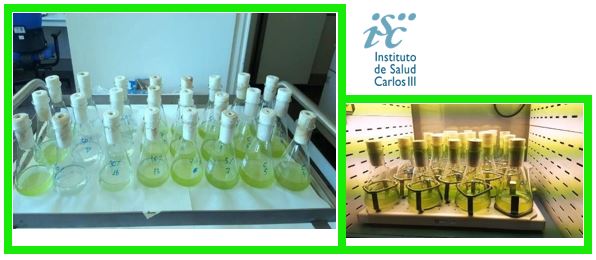
Growth Inhibition Assay on Unicellular Algae (Desmodesmus subspicatus and Chlorella vulgaris)
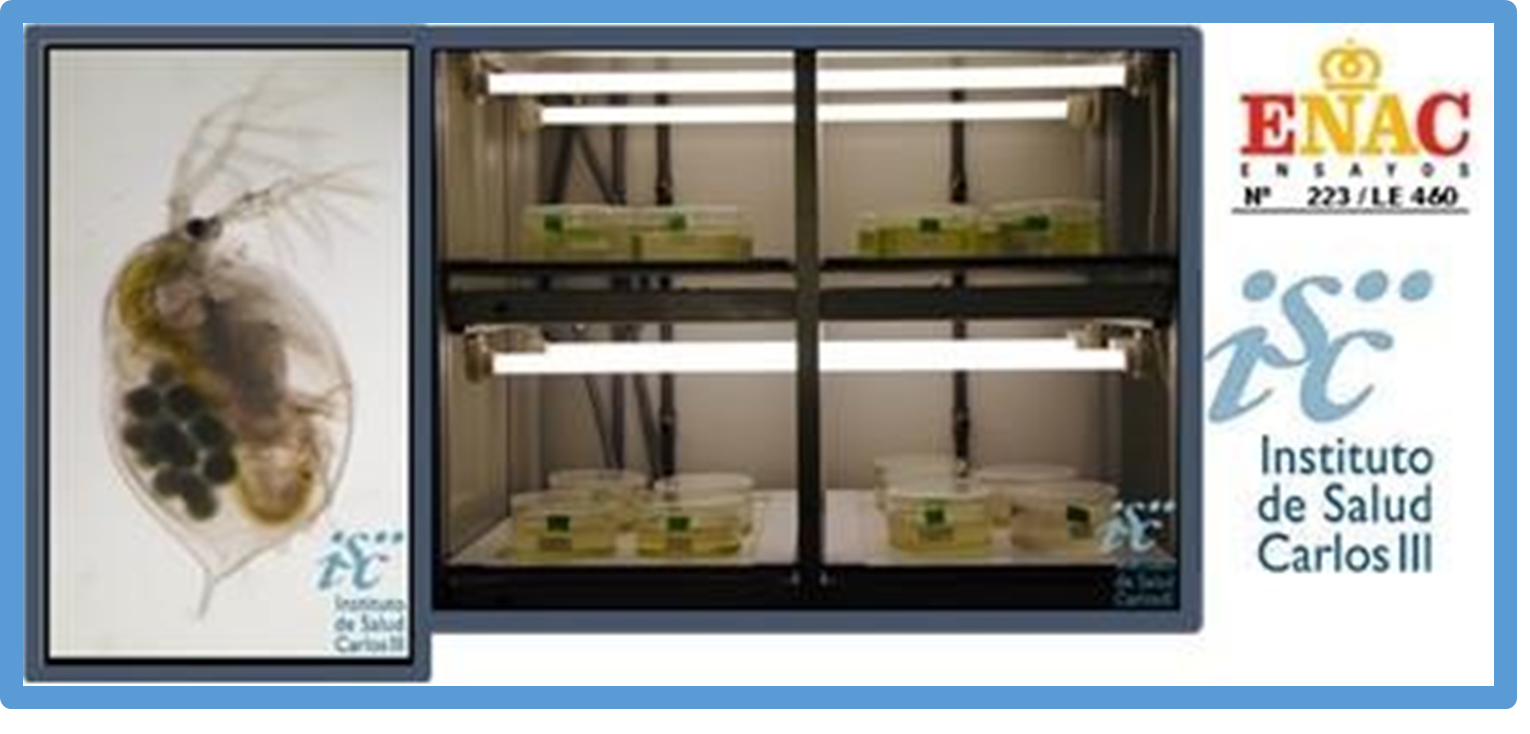
Toxicity test on Daphnia magna
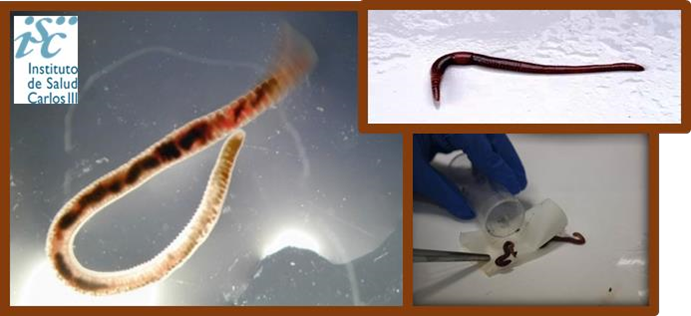
Contact Toxicity Test on earthworm (Eisenia foetida)

Toxicity Test on Artificial Soil with Earthworm (Eisenia foetida)
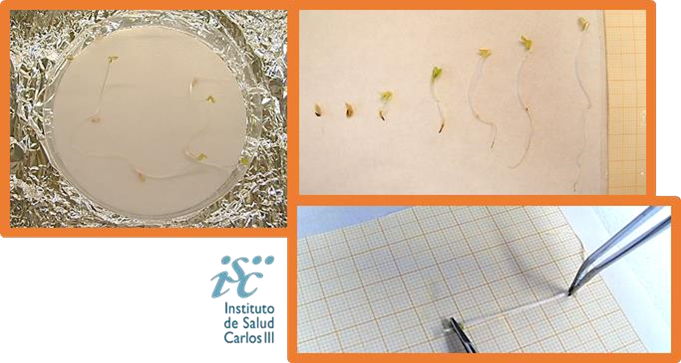
Seed Germination Test with Lactuca sativa
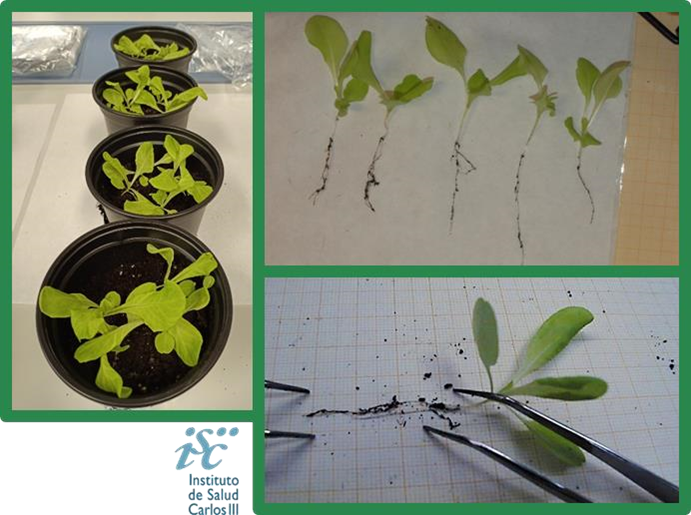
Terrestrial Plant Growth Test (Lactuca sativa)
Conclusions
Once the toxicity levels have been established, at the established application doses, the acute toxicity effects are not foreseeable. The low acute toxicity of the three biopesticide formulations studied in the selected biological indicators shows the absence of ecotoxicological effects.
From the results obtained, taking into account the determination of the hazard weighting foreseen in the current legislation for the three new biopesticide formulations evaluated in their final application, it can be said that their ecotoxicological hazard is low.
B.3.4- Comparison of ecotoxicological risks of new product formulations with those currently on the market
The use of chemical means of defence in agriculture has been a common practice, due to the benefits it brings. However, it has been shown that many of them are harmful to the environment, so an alternative may be other means of defence of natural origin.
The aim of this activity is to achieve more sustainable agricultural production by reducing the use of chemical plant protection products and introducing compounds of natural origin with less risk to the aquatic and terrestrial environment.
It is necessary to know what effect is produced in the environment after exposure to these products, for which we have a methodology that will allow us to establish the toxicity parameters with which we can carry out an ecotoxicological evaluation and determine their toxicological profile.
To this end, the ecotoxicity results obtained with the new biopesticides in the ISCIII laboratories were compared with those found in the available bibliography of the phytosanitary products already on the market (fungicides and insecticides), establishing ecotoxicity ranges.
These new formulations have been shown to be effective and to pose less risk to the aquatic and terrestrial environment compared to other chemical crop protection products, and the use of chemicals in stone fruit tree cultivation can be reduced.
Conclusions
The objective of this action is to align with the European Commission's 'Farm to Fork' strategy, which aims to achieve more sustainable agricultural production, with a focus on reducing the use of chemical pesticides by 2030.
These new formulations have been shown to be effective and to pose less risk to humans and the aquatic and terrestrial environment, compared to other chemical pesticides, and the use of chemical substances in stone fruit tree cultivation can be reduced.
In this way, one of the priority objectives of the project can be demonstrated, which is to achieve biopesticides that are safer for humans and less risky for the aquatic and terrestrial environment, thus being more sustainable from an environmental point of view.
